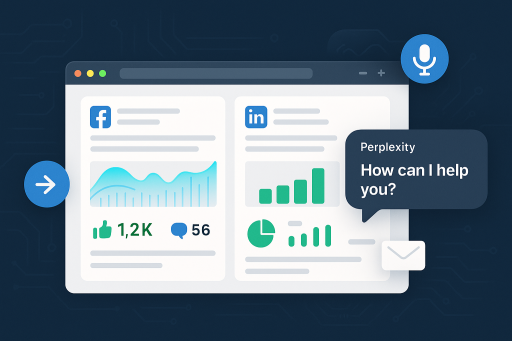The AI Browser Revolution Has Arrived
Hey there! Can you believe we finally have a browser with AI baked right in? I mean, really baked in, not just some chatbot sitting in the corner. I just got my hands on Perplexity’s new Comet browser, and honestly, I’m still buzzing from the experience.
You know that feeling when you discover something that makes you think “this changes everything”? That’s exactly what happened when I fired up Comet for the first time. Instead of doing some polished demo, I decided to take you along for the ride and see what this thing could actually do.
First Impressions: It’s Like Having a Digital Assistant Who Actually Gets It
Setting up Comet was surprisingly smooth. It imported all my Chrome data without a hitch, which is always a relief. You don’t want to spend hours rebuilding your digital life, right?
The moment I opened it up, I could see this wasn’t just another browser with AI slapped on top. The assistant lives right there in your browser, ready to help with whatever you’re doing. It’s kind of like Microsoft Copilot, but it feels more natural, more conversational.
I started simple: “What’s trending in AI?” The search worked beautifully, giving me results powered by Perplexity’s model instead of traditional search. But here’s where it got interesting.
The Voice Interface That Actually Works
I’ve tried voice interfaces before, and let’s be honest, they’re usually more frustrating than helpful. But Comet’s voice feature? It actually understands context and responds naturally.
I asked it to navigate to websites for me, and while there were a few hiccups with URLs (those dashes can be tricky!), it handled most requests smoothly. The real magic happened when I started asking it to analyze content on the pages I was visiting.
The Game-Changer: Social Media Analysis That Actually Works
Now here’s where things got really exciting. I’ve been trying to crack the code on analyzing social media engagement for ages. You know how it goes – you want to figure out which posts perform best so you can create more content like that.
I’ve tried Python scripts, various APIs, even ChatGPT’s browser agent. Nothing worked the way I wanted it to. Facebook’s API permissions are locked down tighter than Fort Knox, and other AI tools just couldn’t handle the complexity.
But Comet? It sailed right through.
I asked it to go through my Facebook profile and copy my last seven posts. Not only did it do that, but when I asked it to find my top three posts by engagement and create templates based on them, it delivered gold.
The templates it created were spot-on. It identified patterns like “family achievement celebrations,” “behind-the-scenes tech projects,” and “community event experiences.” Then it gave me a repeatable formula I could use with any AI tool to consistently create engaging content.
Testing the Limits: Can It Work for Others Too?
Of course, I had to push further. I navigated to other public profiles – Brad Hart, Austin Armstrong – and asked Comet to do the same analysis. And you know what? It worked flawlessly.
For Brad Hart’s page, it identified his most engaging content themes and created templates around his “turning point reflection” style posts. For Austin Armstrong, it picked up on his motivational quotes and behind-the-scenes performance content.
This isn’t just cool – it’s revolutionary for content creators and marketers. But here’s my plea: let’s not ruin this tool. Use it ethically, use it to help people, not to spam or manipulate.
Beyond Social Media: Email, LinkedIn, and More
The social media analysis was impressive enough, but Comet didn’t stop there. It connected to my Gmail and could summarize recent emails. It went through my LinkedIn connection requests and flagged high-profile individuals I might want to connect with.
Think about that for a second. As someone who values networking and connecting people, having an AI assistant that can help identify valuable connections saves hours of manual work. It’s like having a research assistant who never sleeps.
The Voice Experience Keeps Getting Better
Throughout the session, I kept coming back to the voice interface. There’s something magical about having a natural conversation with your browser. When I asked about aliens (hey, we all have those curious moments), it didn’t just give me generic information – it opened relevant websites and provided key takeaways about recent interstellar object discoveries.
The conversation felt natural, not robotic. It understood context, remembered what we were discussing, and even showed a bit of personality.
What This Means for the Future
I’ve been using Claude for a lot of my daily computer tasks because of its computer control capabilities. But Comet fills a gap that I didn’t even realize existed – seamless web browsing with AI assistance that actually understands what you’re trying to accomplish.
While Opera has some AI features and Microsoft Edge has Copilot built-in, Comet feels different. It’s not just AI added to a browser – it’s a browser built with AI as a core component.
For content creators, marketers, researchers, or anyone who spends significant time online, this could be a game-changer. The ability to analyze, summarize, and act on web content in real-time opens up possibilities we’re just starting to explore.
Final Thoughts: The Future is Here
After spending just 15-20 minutes with Comet, I’m genuinely excited about what’s possible. We’re looking at a future where your browser isn’t just a window to the internet – it’s an intelligent partner that helps you navigate, analyze, and act on information in ways we’ve never had before.
Will I be diving deeper into Comet’s capabilities? Absolutely. There’s so much more to explore, especially around automation, content creation, and business workflows.
The AI browser revolution isn’t coming – it’s here. And if Comet is any indication, we’re in for an incredible ride.
What would you want to try first with an AI-powered browser? The possibilities seem endless, and honestly, that’s the most exciting part.




